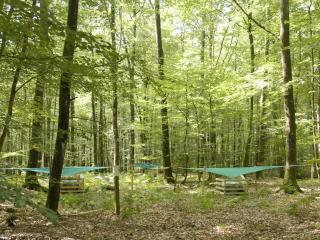Quantitative and Evolutionary Ecology of Communities Group
Members

Doctorante
UCBL

Professeure des universités
VetAgro-Sup
Tel: 33 04 72 43 27 56

Directeur de recherche
CNRS
Tel: 33 04 72 43 27 57

Doctorant
UCBL
Tel: 04 72 44 81 42

Doctorant
CNRS
Tel: 04 72 44 81 42
Doctorant
VetAgro-Sup

Maître de conférences
UCBL
Tel: 04 72 44 81 42
Doctorant
UCBL


Professeur des universités
UCBL
Tel: 33 04 72 43 27 56

Professeur des universités
UCBL

Directeur de recherche
CNRS
Tel: 33 04 72 43 27 56

Maîtresse de conférences
UCBL
Tel: 33 04 72 43 29 02
Maître de conférences
UCBL
Tel: 33 04 72 43 29 02

Our research activities, focused on interspecific interactions (community ecology), aim to better understand the ecological and evolutionary processes structuring species assemblages and biodiversity at different temporal and spatial scales. Our team addresses these major issues using contrasting biological models (communities of large African mammals, insects, microbiota, plants) from 3 complementary angles:
- Our work is strongly anchored in the conceptual framework of evolutionary biology by studying (i) the diversity of adaptive responses implemented by organisms to selective pressures in their environment, (ii) their consequences on population demography and ultimately (iii) the dynamics and composition of species communities.
- Our research is closely linked to societal issues of biodiversity conservation and management by integrating both the functioning of socio-ecological systems and the context of climate change. We conduct experimental studies, manage and ensure the long-term monitoring of several community observation networks.
- Methodological issues also occupy a central place in our team, with the development of new tools for statistical processing and modeling of ecological data. This activity leads to the development of methods and software that we develop and distribute freely.
Research programs

Functioning of African savanna communities
The Hwange LTSER (Long-Term Socio-Ecological Research site in Zimbabwe hosts a long-term interdisciplinary research program that focuses on the functioning of plant and animal communities within the Hwange National Park and the interactions between this protected area and humans living in its periphery. Based on this program, three axes are developed: (1) studying the population dynamics of elephants, exploring their impact and that of management policies on the socio-ecosystem functioning; (2) Understanding the extent to which interactions within and between trophic levels are sensitive to management actions (e.g. sport hunting, water management) and climate change; (3) Decoding human ecology and human-wildlife coexistence mechanisms towards integrated conservation and sustainable functioning of the socio-ecosystem. This research is complemented by more recent works in the Hluhluwe-iMfolozi Park and in the Madikwe reserve in South Africa, which focus on the role of environmental conditions on the hunting success of large African carnivores. We work in close collaboration with the IRL (International Research Lab) Rehabs.
Involved group members : Alice Bernard, Laura Lacomme, Aïssa Morin, Lisa Nicvert, Elie Pedarros, Yolan Richard, Marion Valeix*

Masting and the community dynamics of seed consumers
Masting is a reproductive strategy often encountered in perennial plants, characterized by fructifications highly fluctuating in time and being synchronized at the population level. The seeds produced that way constitute a pulsed resource with a strong impact on the eco-evolutionary dynamics of seed-consuming communities and forest regeneration. Our lack of knowledge of this system still impedes our understanding of the dynamics of temperate forest ecosystems and its future in the context of climate change. Our work carried out on oak forests aims to better understand (i) the proximal causes of masting, (ii) the mechanisms underlying the coexistence of species competing for such highly fluctuating resource and (iii) the co-evolution of consumer exploitation strategies for the fluctuating resource and forest tree fruiting strategies. On the basis of the results obtained, scenarii will be proposed on the future of forest regeneration under climate change, that may serve forest management.
Involved group members : Marie-Claude Bel-Venner*, Emilie Fleurot, Léa Keurinck, Jean Lobry, Samuel Venner

The spread of antibiotic resistance genes in bacteria
Antibiotic resistance is recognized as one of the greatest current threats to human health, and the mobile genetic elements (MGEs) that circulate in bacterial populations and communities are the main vehicles. To understand the dynamics and diversity of MGEs in bacterial pangenomes and the emergence of antibiotic resistance genes, we propose to go beyond the framework of conventional genomics by considering pangenomes as complex ecological communities. In the Ab-One program, we mobilize the concepts and tools developed in community ecology based on an integrative approach (monitoring of bacterial populations/communities evolving in contrasting environments -One-Health approaches-, pan-genomic analyses, experimentation in molecular and cellular microbiology, mathematical modelling). This program is currently focused on the dynamics of MGEs in Acinetobacter baumannii, an antibiotic-resistant microorganism classified as a priority by the WHO. Other more general approaches will illustrate the relevance of this new conceptual framework to understand the dynamics and diversity of MGEs in bacterial pangenomes. This program, co-piloted by our team and a team from CIRI (Horigene) involves the participation of 9 organizations (6 from Lyon -LBBE, CIRI, MMSB, HCL, LEM, VetAgro Sup-, Institut Pasteur (Paris), LMGM (Toulouse ), Robert Koch Institute (Germany)).
Involved group members : Stéphane Dray, Rémi Tuffet, Samuel Venner*

Statistical analysis of ecological data
Understanding the structure and dynamics of species assemblages, and the processes behind them, requires collecting data that are becoming increasingly complex owing to the sophisticated technological developments made available for their acquisition (e.g. GPS, loggers, satellite imagery, molecular data). We are developing new methods for analysing such data, that provide new insights into the ecological processes at work in communities. Multivariate analysis methods allow the analysis of spatial structures, accounting for various information on species (functional traits, morphology, phylogeny), the spatio-temporal variation of species-environment relationships or the multifaceted perception of the protected human-environment relationship. We also model multi-'omics' dose-response data within communities in order to better understand the Adverse Outcome Pathway (AOP) and to better appreciate the risks to the environment. These methodological innovations are made available to the scientific community through the development, distribution and maintenance of software (libraries for the R language: ade4, adegraphics, adephylo, ade4TkGUI, nlstools, fitdistrplus, DRomics, seqinr).
Involved group members: Marie Laure Delignette-Muller, Stéphane Dray*, Jean Lobry, Jean Thioulouse.
Publications
Display of 121 to 150 publications on 656 in total
Do ecological specialization and functional traits explain the abundance–frequency relationship? Arable weeds as a case study
Journal of Biogeography . 48 ( 1 ) : 37-50
DOI: 10.1111/jbi.13980
Journal article
see the publicationCanopy and understory tree guilds respond differently to the environment in an Indian rainforest
Journal of Vegetation Science . 32 ( 5 )
DOI: 10.1111/jvs.13075
Journal article
see the publicationSmall-Scale Variability in Bacterial Community Structure in Different Soil Types
Microbial ecology . 82 ( 2 ) : 470-483
Journal article
see the publicationResource Competition and Host Feedbacks Underlie Regime Shifts in Gut Microbiota
The American Naturalist . 198 ( 1 ) : 1-12
DOI: 10.1086/714527
Journal article
see the publicationFrom competition to facilitation and mutualism: a general theory of the niche
Ecological monographs . 91 ( 3 )
DOI: 10.1002/ecm.1458
Journal article
see the publicationDeterminants of genetic diversity and species richness of North American amphibians
Journal of Biogeography . 49 ( 11 ) : 2005-2015
Journal article
see the publicationCounter‐gradient variation of reproductive effort in a widely distributed temperate oak Quercus petraea
Functional Ecology . : 1-11
Journal article
see the publicationWater Quality Shapes Freshwater Macroinvertebrate Communities in Northern Tunisia
Recent Advances in Environmental Science from the Euro-Mediterranean and Surrounding Regions (2nd Edition) . : 1915-1919
Book chapter
see the publicationWithin-host genetic micro-diversity of Mycobacterium tuberculosis and the link with tuberculosis disease features
Preprint
see the publicationHow does interspecific competition modify the response of grass plants against herbicide treatment? A hierarchical concentration-response approach
Science of the Total Environment . 778 : 146108
Journal article
see the publicationEvaluation using latent class models of the diagnostic performances of three ELISA tests commercialized for the serological diagnosis of Coxiella burnetii infection in domestic ruminants
Gemeinsamen Arbeitstagung der Nationalen Referenzlabore Chlamydiose, Q-Fieber, Paratuberkulose und Tuberkulose der Rinder - Online-Tagung veranstaltet . : 17 slides
Conference paper
see the publicationEvaluation using latent class models of the diagnostic performances of three ELISA tests commercialized for the serological diagnosis of Coxiella burnetii infection in domestic ruminants
Veterinary Research . 52 ( 1 )
Journal article
see the publicationPhenotypic and Transcriptomic Responses to Stress Differ According to Population Geography in an Invasive Species
Genome Biology and Evolution . 13 ( 9 ) : evab208
DOI: 10.1093/gbe/evab208
Journal article
see the publicationOvercoming the Spurious Groups Problem in Between-Group PCA
Evolutionary Biology .
Journal article
see the publicationAre human natal sex ratio differences across the world adaptive? A test of Fisher's principle
Biology Letters . 17 ( 3 )
Journal article
see the publicationEvaluation, à l’aide de modèles à classes latentes, des performances diagnostic des tests ELISA commercialisés pour le diagnostic sérologique des infections par Coxiella burnetii chez les ruminants domestiques
17ème Rencontre des Microbiologistes du Pôle Clermontois .
Conference paper
see the publicationRevisiting animal photo-identification using deep metric learning and network analysis
Methods in Ecology and Evolution . 12 ( 5 ) : 863-873
Journal article
see the publicationRifampicin exposure reveals within-host Mycobacterium tuberculosis diversity in patients with delayed culture conversion
PLoS Pathogens . 17 ( 6 ) : e1009643
Journal article
see the publicationLong‐term high densities of African elephants clear the understorey and promote a new stable savanna woodland community
Journal of Vegetation Science . 32 ( 6 )
DOI: 10.1111/jvs.13101
Journal article
see the publicationÉvaluation des caractéristiques de trois kits ELISA pour le diagnostic de la fièvre Q chez les ruminants domestiques par des modèles à classes latentes
Groupe de travail sur les avortements des petits ruminants, GDS France .
Conference paper
see the publicationExploration d’outils complémentaires à la surveillance évènementielle des maladies abortives des ruminants par le dispositif OSCAR : application à la fièvre Q et la leptospirose – État d’avancement au 6 janvier 2020
Groupe de travail sur les avortements des petits ruminants, GDS France .
Conference paper
see the publicationLoss of pollinator specialization revealed by historical opportunistic data: Insights from network-based analysis
PLoS ONE . 15 ( 7 ) : e0235890
Journal article
see the publicationModelling for risk assessment
Journées du LIEC : l’interdisciplinarité au service de l’environnement .
Conference paper
see the publicationGeneralist plants are more competitive and more functionally similar to each other than specialist plants: insights from network analyses
Journal of Biogeography . 47 ( 9 ) : 1922-1933
DOI: 10.1111/jbi.13848
Journal article
see the publicationAuthor Correction: Complex ecological interactions of Staphylococcus aureus in tampons during menstruation
Scientific Reports . 10 ( 1 ) : 1848
Journal article
see the publicationAssessing metacommunity processes through signatures in spatiotemporal turnover of community composition
Ecology Letters . 23 ( 9 ) : 1330-1339
DOI: 10.1111/ele.13523
Journal article
see the publicationEcological Specialization and Rarity of Arable Weeds: Insights from a Comprehensible Survey in France
Plants . 9 ( 7 ) : 824
Journal article
see the publicationWeeds: Against the Rules?
Trends in Plant Science . 25 ( 11 ) : 1107-1116
Journal article
see the publication
You also, comment on this article